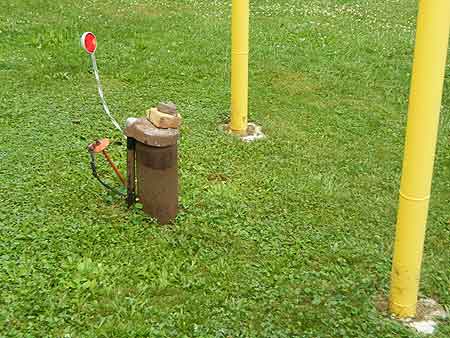Article and photo by Gregory Havel
Many homes and commercial buildings in rural and suburban areas have no city water and no fire hydrants. These facilities get their domestic water supplies from private wells located near the buildings, usually in the lawn or other green space. These private wells, combined with pressure tanks, provide enough water for domestic and sanitary use, but not for firefighting.
A typical modern small well has a steel casing that extends down to bedrock and from 12 inches to 18 inches (305 mm 458 mm) above the surrounding ground level. It will have a rain-tight and vermin-proof cap and a screened vent on the underside to equalize air pressure in the well as the water level changes during pump operation. The well will contain a submersible electric pump, which discharges the water to the building through a pipe that is buried five to six feet below ground level.
The well casing and cap are often painted to blend in with the surroundings, making them difficult to see in daylight and impossible to see at night and in smoke. Since the well is likely to be in an open area through which firefighters will move with ladders, hoselines, and other equipment, it can be an obstacle to firefighters.

(1)
Photo 1 shows a private well at a residence in a rural area. The steel well casing extends about 16 inches (406 mm) above ground level. The smaller pipe to its left, also covered by the well cap, is the conduit that carries the electric wires from the house to the well pump. The yellow posts at the right are to prevent the well from being struck by the snow plow. However, this well was struck by a lawn tractor, which broke the cap away from the well casing, leaving it open to contamination by rain, airborne dust and bacteria, and insects. The pieces of brick on top of the cap are holding it in place, but the cap is no longer rain-tight or vermin-proof; and the water in the well is probably contaminated by bacteria.
“Rain-tight” means that falling rain will be unable to contaminate the well. It does not mean that it is water-tight against fire streams. They have enough power that they can force water through the vent or seal and into the well. They also have enough power to churn up the ground around the well and splash mud through the vent screen.
If the operations area at an incident includes a well like the one shown, our concern for the well-being of our customers (the residents at the house or the occupants of the business) should remind us to check the well casing and cap for visible damage before we leave the scene. It should also remind us to notify the owner or occupant if damage is found or if there is evidence of hose stream activity or disturbed ground in the area and to suggest a test for coliform bacteria and E. coli, to ensure that the water in the well has not been contaminated.
Possible damage and harm that can be accidentally done to a private well include the following:
- Cracked well cap
- Bent or cracked well casing
- Broken electrical conduit
- Damaged vent screen
- Water, soil, or mulch (which contain bacteria) splashed through the vent or seal into the well
All of these can expose the well and its water to contaminants that cause health problems. This is especially true in rural areas, where firefighting water is carried by tank trucks (water tenders), which are not emptied, flushed, and refilled frequently with potable water–water suitable for drinking. In many rural areas, fire department tank trucks are filled from rivers, lakes, and ponds and contain all of the bacteria that were in the water when the trucks were filled, plus all of the bacteria that have grown in the water while it has been stored inside a warm fire station.
Both public and private wells and water systems and the groundwater and aquifers from which they pump their water are regulated by the U.S. Environmental Protection Agency (EPA), as well as by state and local natural resources agencies. The regulations are intended to maintain a clean and safe drinking water supply for everyone, as well as to protect the groundwater. Damage to the seal on a well can introduce contaminants into the well and the groundwater and aquifer, contaminating other wells in the neighborhood. Contaminants of concern to the EPA and other regulatory agencies, besides coliform bacteria and E. coli include naturally occurring minerals and metals, petroleum products and solvents, and pesticides. For more information on well contamination, visit the Web site http://water.epa.gov/drink.
Download this article as a PDF HERE.


